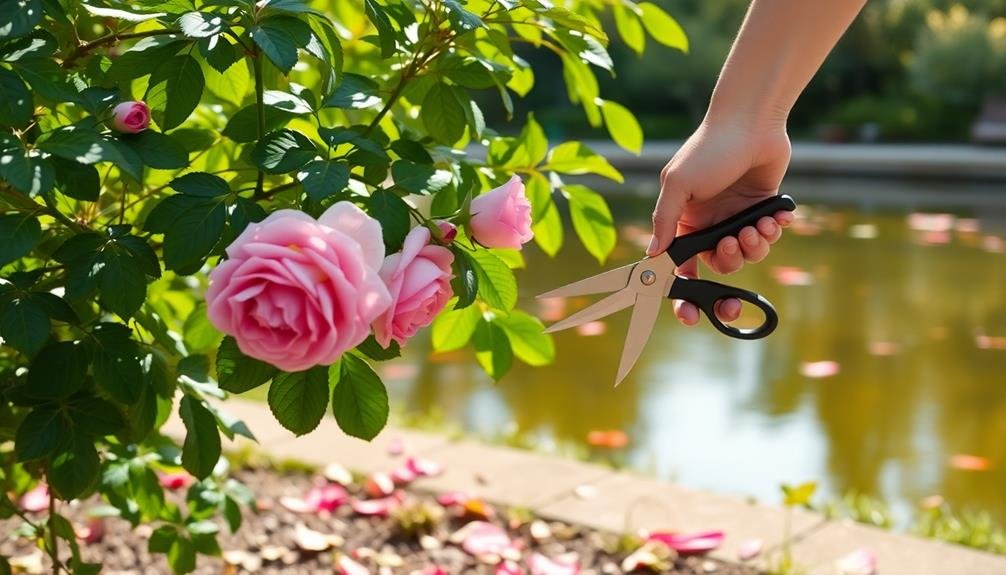Transform your garden pruning into a therapeutic experience with these five anxiety-easing tips. First, practice mindful snipping by focusing on each cut and engaging your senses. Second, turn pruning into a meditation by synchronizing your breath with rhythmic movements. Third, use focused shaping to improve mental clarity and shift attention from worries. Fourth, deepen your connection with nature through careful trimming and observation. Finally, view pruning as a metaphor for life, letting go of what no longer serves you. These techniques can help you cultivate inner peace while tending to your garden. Explore further to uncover the full potential of garden therapy.
Key Takeaways
- Synchronize your breathing with each pruning cut to calm your mind and reduce anxiety.
- Focus on engaging all senses while pruning to ground yourself in the present moment.
- Use sharp, clean tools to enhance enjoyment and ease of the pruning task.
- Visualize releasing tension with each cut, promoting a refreshed and centered state.
- Approach pruning as a metaphor for life, letting go of what no longer serves you.
Mindful Snipping for Stress Relief

Snipping away at your plants can be a surprisingly therapeutic activity. As you focus on trimming branches and shaping your greenery, you'll find your mind drifting away from daily stressors. To maximize this calming effect, approach pruning with mindfulness and intention.
Begin by selecting the right tools for the job. Sharp, clean pruners will make your task easier and more enjoyable. Take a moment to breathe deeply and set your intention for the pruning session.
As you work, pay attention to the sensations: the weight of the tool in your hand, the resistance of the stems, and the satisfying snip as you make each cut. Move slowly and deliberately, observing the plant's structure and growth patterns.
This mindful approach not only benefits your mental state but also helps you make better pruning decisions. Listen to the rustling leaves and birdsong around you, grounding yourself in the present moment.
Don't rush the process. Allow yourself to become fully absorbed in the task, letting go of worries and to-do lists. With each cut, visualize releasing tension and anxiety, leaving you feeling refreshed and centered.
Rhythmic Pruning as Meditation

Building on the mindful approach to pruning, you can elevate this practice into a form of meditation. Focus on the repetitive motion of your pruning shears as you work through your garden. Let the steady rhythm of opening and closing the blades become a calming mantra, grounding you in the present moment.
As you prune, synchronize your breathing with each cut. Inhale as you open the shears, exhale as you close them. This rhythmic pattern will help slow your heart rate and calm your mind. Pay attention to the sensation of the tool in your hand, the resistance of the stems, and the subtle changes in your body as you move.
Don't rush through the task. Instead, maintain a steady, unhurried pace. Allow your thoughts to flow without judgment, acknowledging them before gently returning your focus to the pruning rhythm.
As you continue, you'll likely find your mind becoming clearer and more settled. This meditative approach to pruning not only benefits your plants but also provides a therapeutic outlet for managing anxiety and stress.
It's a practical way to combine garden maintenance with self-care, leaving both your garden and your mind in better shape.
Focused Shaping for Mental Clarity

When you're feeling scattered or overwhelmed, focused shaping can help restore mental clarity. This pruning technique involves carefully sculpting plants into specific forms, requiring intense concentration and attention to detail. As you trim and shape, you'll find your mind naturally shifting away from anxious thoughts and onto the task at hand.
Choose a plant or shrub that's overgrown and visualize its ideal shape. Then, work methodically to bring that vision to life. Start with larger branches and gradually move to smaller areas, making precise cuts as you go. This process encourages mindfulness and helps you practice decision-making in a low-stakes environment.
To enhance your focused shaping experience, try to engage your senses:
- Feel the texture of leaves and bark beneath your fingers
- Listen to the soft snip of pruning shears
- Inhale the fresh scent of cut foliage
- Observe the changing silhouette as you work
As you progress, you'll likely notice your thoughts becoming clearer and more organized. The act of transforming a chaotic plant into a well-defined shape can mirror the process of sorting through mental clutter, leaving you feeling more centered and in control.
Nature Connection Through Careful Trimming

Through careful trimming, you can forge a deeper connection with nature. As you prune, focus on each plant's unique structure and growth patterns. This mindful approach helps you understand the plant's needs and natural tendencies, strengthening your bond with the garden.
Observe how different species respond to pruning. Some plants, like lavender, thrive with regular trimming, while others prefer minimal intervention. By tailoring your approach, you'll develop a more intuitive understanding of your garden's ecosystem.
Listen to the sounds around you as you work—rustling leaves, chirping birds, or buzzing insects. These natural noises can ground you in the present moment, reducing anxiety and enhancing your connection to the environment.
Feel the textures of leaves, stems, and bark as you trim. This tactile experience heightens your awareness of the plant's life and structure. Notice the scents released as you prune aromatic plants like rosemary or mint, allowing these natural fragrances to calm your mind.
Pruning as Metaphor for Life

Pruning offers more than just garden maintenance—it's a powerful metaphor for life. As you carefully trim away dead branches, you're reminded of the importance of letting go of what no longer serves you.
You'll find that cutting back overgrown areas allows for new growth and possibilities, just as clearing mental clutter can create space for fresh ideas and opportunities.
Consider these pruning parallels to life:
- Removing dead wood: Letting go of toxic relationships
- Shaping for balance: Prioritizing work-life equilibrium
- Encouraging new growth: Embracing personal development
- Timing cuts strategically: Making decisions at the right moment
When you prune, you're making choices about what stays and what goes. This process mirrors the decisions you face daily—which commitments to keep, which habits to cultivate, and which goals to pursue.
By approaching pruning mindfully, you'll develop a deeper understanding of your own growth patterns and potential. You'll learn to recognize when it's time to cut back and when to allow things to flourish.
Ultimately, pruning teaches you that sometimes, less is more, and that strategic removal can lead to a more vibrant, balanced life.
Frequently Asked Questions
What Tools Are Essential for Therapeutic Pruning Sessions?
You'll need sharp, clean pruning shears for precise cuts. Don't forget gloves to protect your hands. A pruning saw is useful for thicker branches. Carry a small bucket for collecting debris as you work.
How Often Should I Prune for Optimal Mental Health Benefits?
You should prune regularly, but don't overdo it. Aim for weekly or bi-weekly sessions, depending on your garden's needs and your schedule. Consistent, short pruning sessions can provide ongoing mental health benefits and stress relief.
Can Pruning Therapy Be Done Indoors With Houseplants?
You can practice pruning therapy with indoor plants. It's just as calming and satisfying as outdoor gardening. Focus on your houseplants' needs, trim dead leaves, shape them, and you'll reap the mental health benefits indoors too.
Are There Specific Plants That Offer Better Anxiety-Reducing Pruning Experiences?
You'll find lavender, rosemary, and mint offer calming pruning experiences. They're aromatic and easy to shape. Bonsai trees provide meditative pruning sessions. Succulents are low-stress options, while orchids offer delicate, focused pruning opportunities.
How Can I Incorporate Pruning Therapy Into a Busy Daily Routine?
You can easily fit pruning therapy into your busy day. Start small by keeping a potted plant on your desk. Take short breaks to trim and shape it. You'll find it's a quick, calming ritual.
In Summary
You've discovered the therapeutic power of pruning. By embracing mindful snipping, rhythmic movements, and focused shaping, you're not just tending to your garden—you're nurturing your mind. As you trim and shape, you're connecting with nature and finding clarity. Remember, pruning isn't just about plant care; it's a metaphor for life. So grab your shears, step into your garden, and let the healing begin. Your mind and your plants will thank you.





Leave a Reply